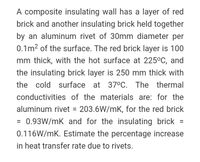
Elements Of Electromagnetics
7th Edition
ISBN: 9780190698614
Author: Sadiku, Matthew N. O.
Publisher: Oxford University Press
expand_more
expand_more
format_list_bulleted
Concept explainers
Question

Transcribed Image Text:A composite insulating wall has a layer of red
brick and another insulating brick held together
by an aluminum rivet of 30mm diameter per
0.1m2 of the surface. The red brick layer is 100
mm thick, with the hot surface at 225°C, and
the insulating brick layer is 250 mm thick with
the cold surface at 370C. The thermal
conductivities of the materials are: for the
aluminum rivet = 203.6W/mK, for the red brick
= 0.93W/mK and for the insulating brick
%3D
%3D
0.116W/mK. Estimate the percentage increase
in heat transfer rate due to rivets.
Expert Solution
This question has been solved!
Explore an expertly crafted, step-by-step solution for a thorough understanding of key concepts.
This is a popular solution
Trending nowThis is a popular solution!
Step by stepSolved in 3 steps with 3 images

Knowledge Booster
Learn more about
Need a deep-dive on the concept behind this application? Look no further. Learn more about this topic, mechanical-engineering and related others by exploring similar questions and additional content below.Similar questions
- Please include a fbd of the problemarrow_forward1) A wall section composed from the outside to inside, of concrete brick 100mm thick, an air space of 50mm, two layers of fiberglass insulation 38mm thick, concrete block 150mm thick and air space of 19mm and a gypsum board of 13mm. The exterior conditions are -20C and RH=90% while the interior conditions are 23C and RH=40%. The surface temperature from the outside to inside are shown in the figure. The permeances are: Still Air: µ = 175 ng/pa.s.m Fiber glass: M=2560 ng/pa.s.m? Concrete block: M= 200 ng/pa.s.m? Gypsum board: M= 2000 ng/pa.s.m? Concrete brick: µ = 4.55 ng/pa.s.m Determine if there is a risk of condensation, and if there is, what is the condensation rate? What would happen if a vapor barrier (M=0.2 ng/pa.s.m²) was installed on the warm side of the insulation (Surface 4). 21с 19C 16 С 12C -10 -15C -18C -19C Gyp Air Concrete Fiber Fiber Air Concrete Outdoor Indoor sum block Glass Glass brick 230 19 50 mm -20C 13 150 mm 38 mm | 38 mm 100 mm RH=90% RH=40% mm mm Surf. 1 Surf.…arrow_forwardSteel pipe (outer diameter 100 mm) is covered with two layers of insulation. The inner layer, 40 mm thick, has a thermal conductivity of 0.07 W / (m K). The outer layer, 20 mm thick, has a thermal conductivity of 0.15 W / (m K). Pipes are used to deliver steam with a pressure of 800 kPa. The temperature on the outer insulation surface is 24 ° C. If the pipe is 10 m long, determine the following: (assuming that the conduction heat transfer resistance of the steel pipe and the vapor convection resistance are negligible). a. Heat loss per hour. = Answer kJ / hour. b. Temperature between insulation layers. = Answer ° C.arrow_forward
Recommended textbooks for you
 Elements Of ElectromagneticsMechanical EngineeringISBN:9780190698614Author:Sadiku, Matthew N. O.Publisher:Oxford University Press
Elements Of ElectromagneticsMechanical EngineeringISBN:9780190698614Author:Sadiku, Matthew N. O.Publisher:Oxford University Press Mechanics of Materials (10th Edition)Mechanical EngineeringISBN:9780134319650Author:Russell C. HibbelerPublisher:PEARSON
Mechanics of Materials (10th Edition)Mechanical EngineeringISBN:9780134319650Author:Russell C. HibbelerPublisher:PEARSON Thermodynamics: An Engineering ApproachMechanical EngineeringISBN:9781259822674Author:Yunus A. Cengel Dr., Michael A. BolesPublisher:McGraw-Hill Education
Thermodynamics: An Engineering ApproachMechanical EngineeringISBN:9781259822674Author:Yunus A. Cengel Dr., Michael A. BolesPublisher:McGraw-Hill Education Control Systems EngineeringMechanical EngineeringISBN:9781118170519Author:Norman S. NisePublisher:WILEY
Control Systems EngineeringMechanical EngineeringISBN:9781118170519Author:Norman S. NisePublisher:WILEY Mechanics of Materials (MindTap Course List)Mechanical EngineeringISBN:9781337093347Author:Barry J. Goodno, James M. GerePublisher:Cengage Learning
Mechanics of Materials (MindTap Course List)Mechanical EngineeringISBN:9781337093347Author:Barry J. Goodno, James M. GerePublisher:Cengage Learning Engineering Mechanics: StaticsMechanical EngineeringISBN:9781118807330Author:James L. Meriam, L. G. Kraige, J. N. BoltonPublisher:WILEY
Engineering Mechanics: StaticsMechanical EngineeringISBN:9781118807330Author:James L. Meriam, L. G. Kraige, J. N. BoltonPublisher:WILEY

Elements Of Electromagnetics
Mechanical Engineering
ISBN:9780190698614
Author:Sadiku, Matthew N. O.
Publisher:Oxford University Press

Mechanics of Materials (10th Edition)
Mechanical Engineering
ISBN:9780134319650
Author:Russell C. Hibbeler
Publisher:PEARSON

Thermodynamics: An Engineering Approach
Mechanical Engineering
ISBN:9781259822674
Author:Yunus A. Cengel Dr., Michael A. Boles
Publisher:McGraw-Hill Education

Control Systems Engineering
Mechanical Engineering
ISBN:9781118170519
Author:Norman S. Nise
Publisher:WILEY

Mechanics of Materials (MindTap Course List)
Mechanical Engineering
ISBN:9781337093347
Author:Barry J. Goodno, James M. Gere
Publisher:Cengage Learning

Engineering Mechanics: Statics
Mechanical Engineering
ISBN:9781118807330
Author:James L. Meriam, L. G. Kraige, J. N. Bolton
Publisher:WILEY